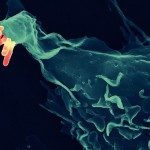Link to Pubmed [PMID] – 30600140
Trends Microbiol. 2018 Dec;
Pathogens survive and propagate within host cells through a wide array of complex interactions. Tracking the molecular and cellular events by multidimensional fluorescence microscopy has been a widespread tool for research on intracellular pathogens. Through major advancements in 3D electron microscopy, intracellular pathogens can also be visualized in their cellular environment to an unprecedented level of detail within large volumes. Recently, multidimensional fluorescence microscopy has been correlated with volume electron microscopy, combining molecular and functional information with the overall ultrastructure of infection events. In this review, we provide a short introduction to correlative focused ion beam/scanning electron microscopy (c-FIB/SEM) tomography and illustrate its utility for intracellular pathogen research through a series of studies on Shigella, Salmonella, and Brucella cellular invasion. We conclude by discussing current limitations of and prospects for this approach.

